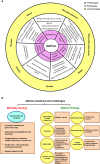Nuclear Receptors in Asthma: Empowering Classical Molecules Against a Contemporary Ailment
- PMID: 33574813
- PMCID: PMC7870687
- DOI: 10.3389/fimmu.2020.594433
Nuclear Receptors in Asthma: Empowering Classical Molecules Against a Contemporary Ailment
Abstract
The escalation in living standards and adoption of 'Western lifestyle' has an allied effect on the increased allergy and asthma burden in both developed and developing countries. Current scientific reports bespeak an association between allergic diseases and metabolic dysfunction; hinting toward the critical requirement of organized lifestyle and dietary habits. The ubiquitous nuclear receptors (NRs) translate metabolic stimuli into gene regulatory signals, integrating diet inflences to overall developmental and physiological processes. As a consequence of such promising attributes, nuclear receptors have historically been at the cutting edge of pharmacy world. This review discusses the recent findings that feature the cardinal importance of nuclear receptors and how they can be instrumental in modulating current asthma pharmacology. Further, it highlights a possible future employment of therapy involving dietary supplements and synthetic ligands that would engage NRs and aid in eliminating both asthma and linked comorbidities. Therefore, uncovering new and evolving roles through analysis of genomic changes would represent a feasible approach in both prevention and alleviation of asthma.
Keywords: asthma; comorbidities; diet; glucocorticoids; nuclear receptors.
Copyright © 2021 Tiwari and Gupta.
Conflict of interest statement
The authors declare that the research was conducted in the absence of any commercial or financial relationships that could be construed as a potential conflict of interest.
Figures





References
-
- Global Asthma Network The Global Asthma Report. (2018). www.globalasthmanetwork.org.
Publication types
MeSH terms
Substances
LinkOut - more resources
Full Text Sources
Other Literature Sources
Medical
Research Materials

